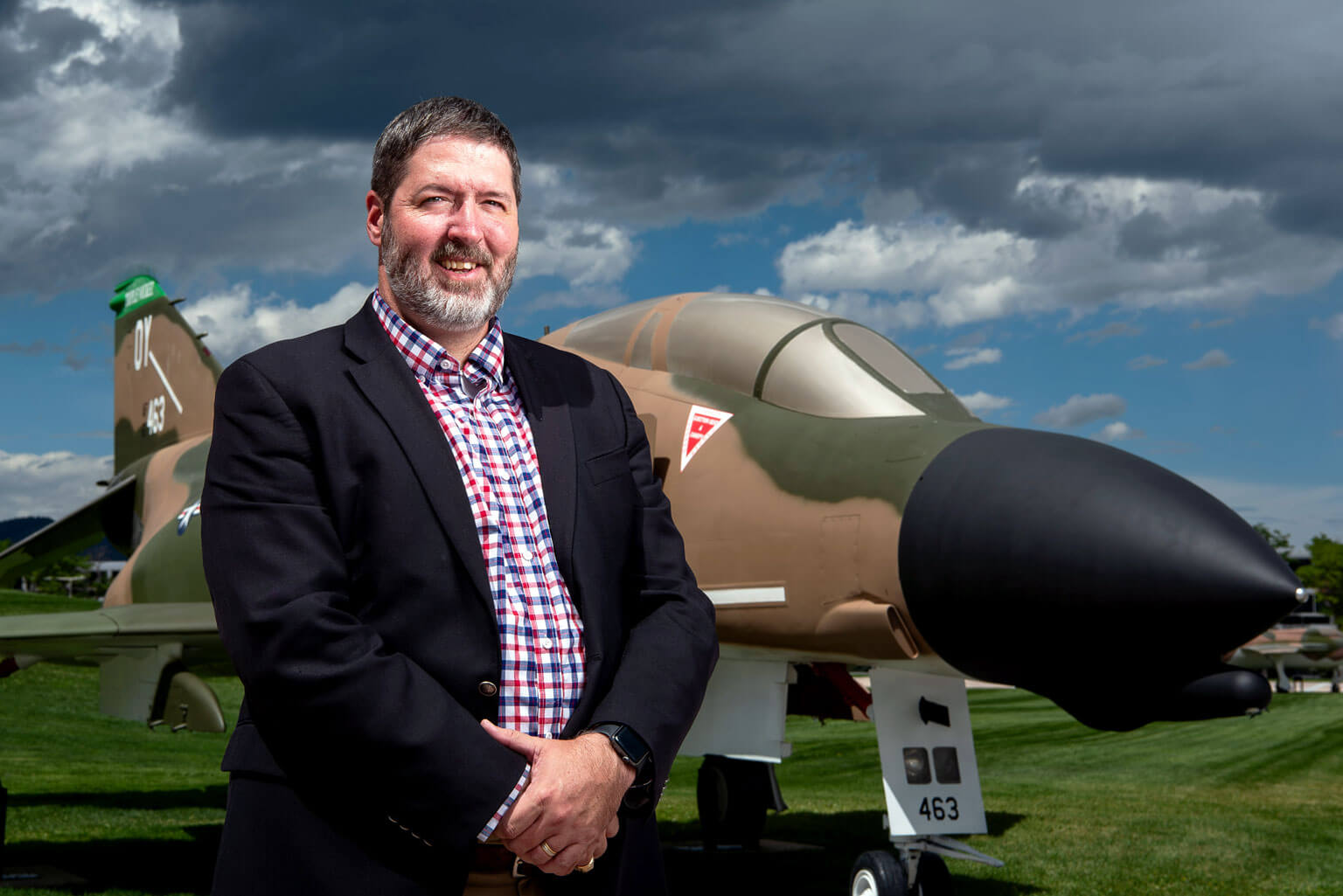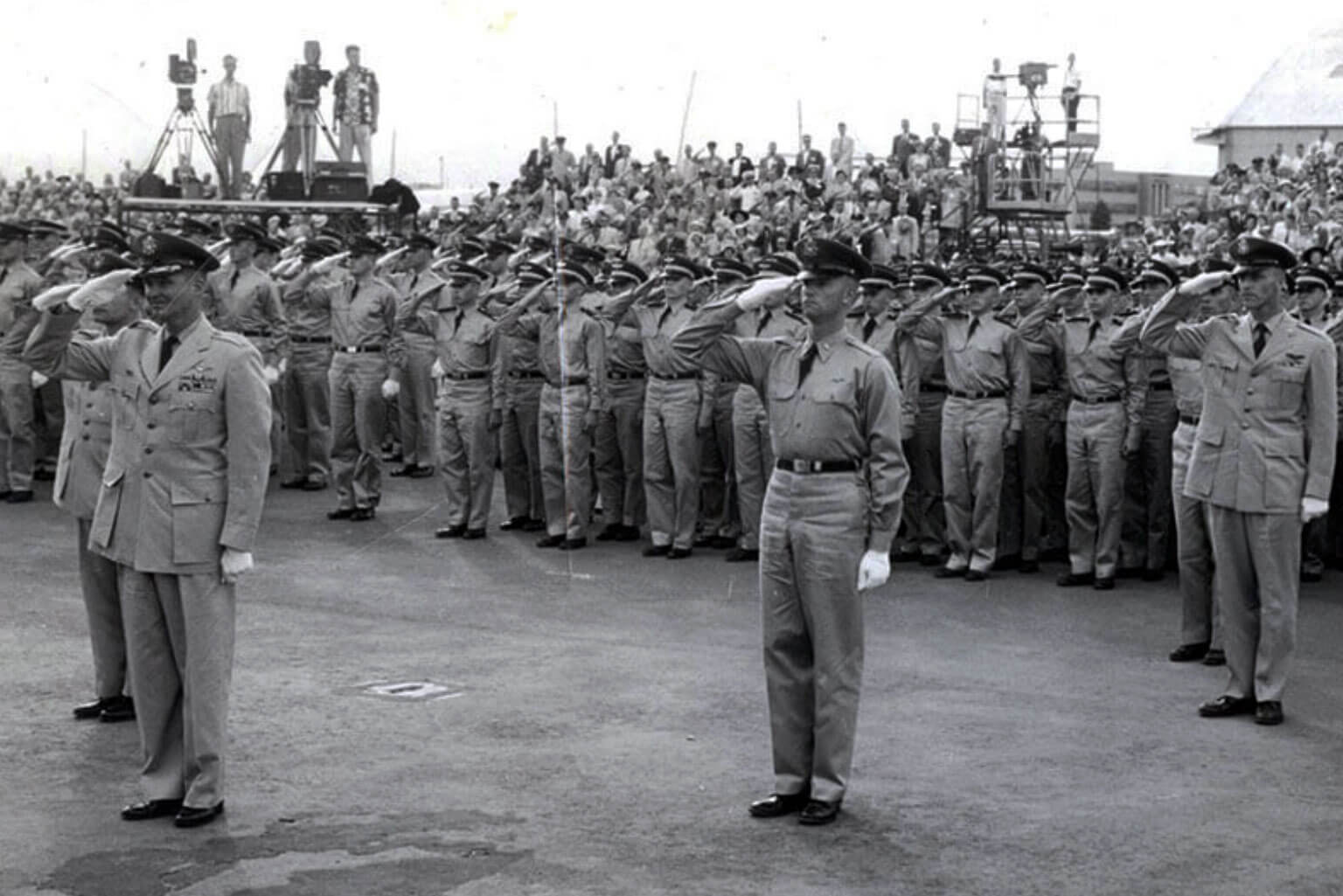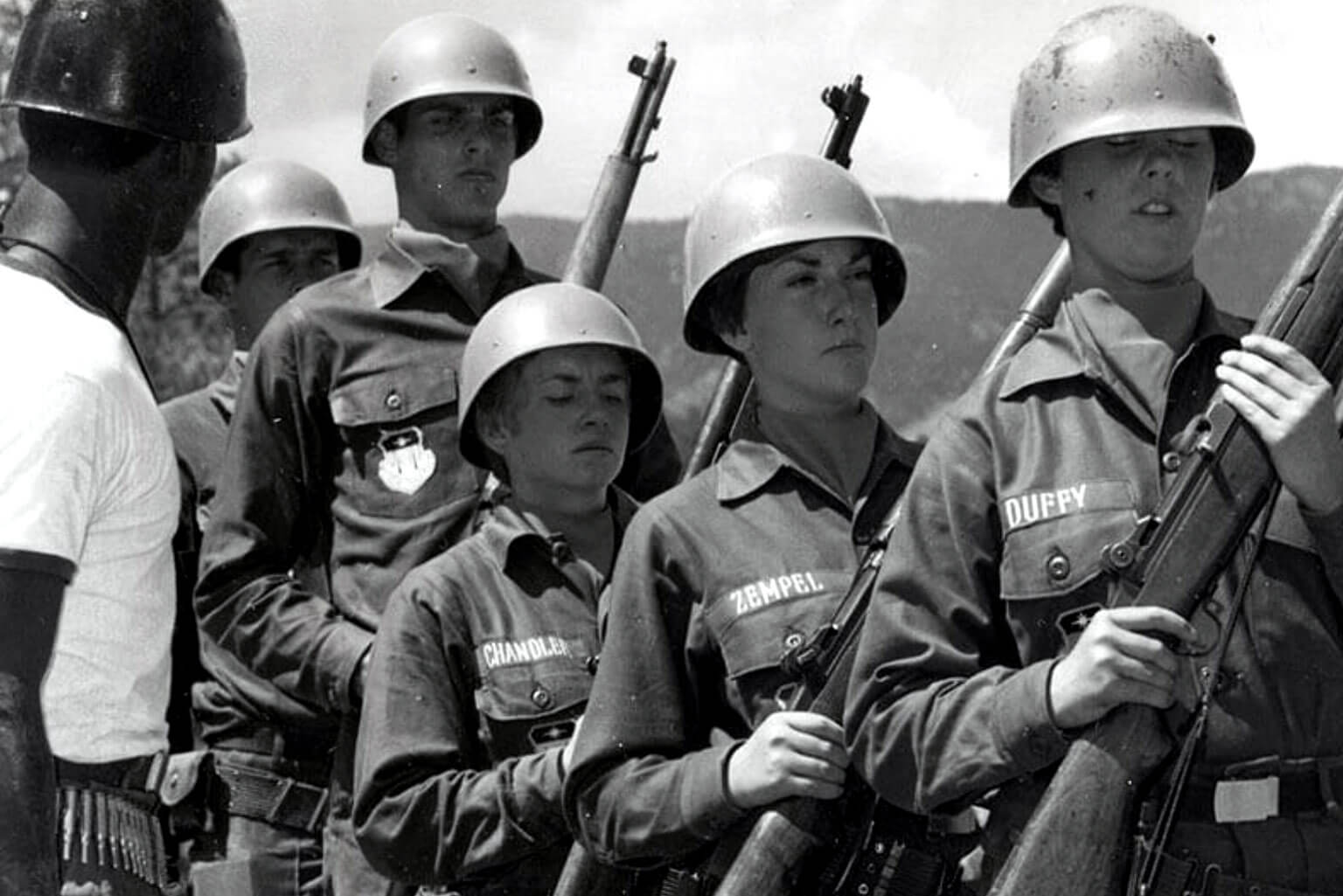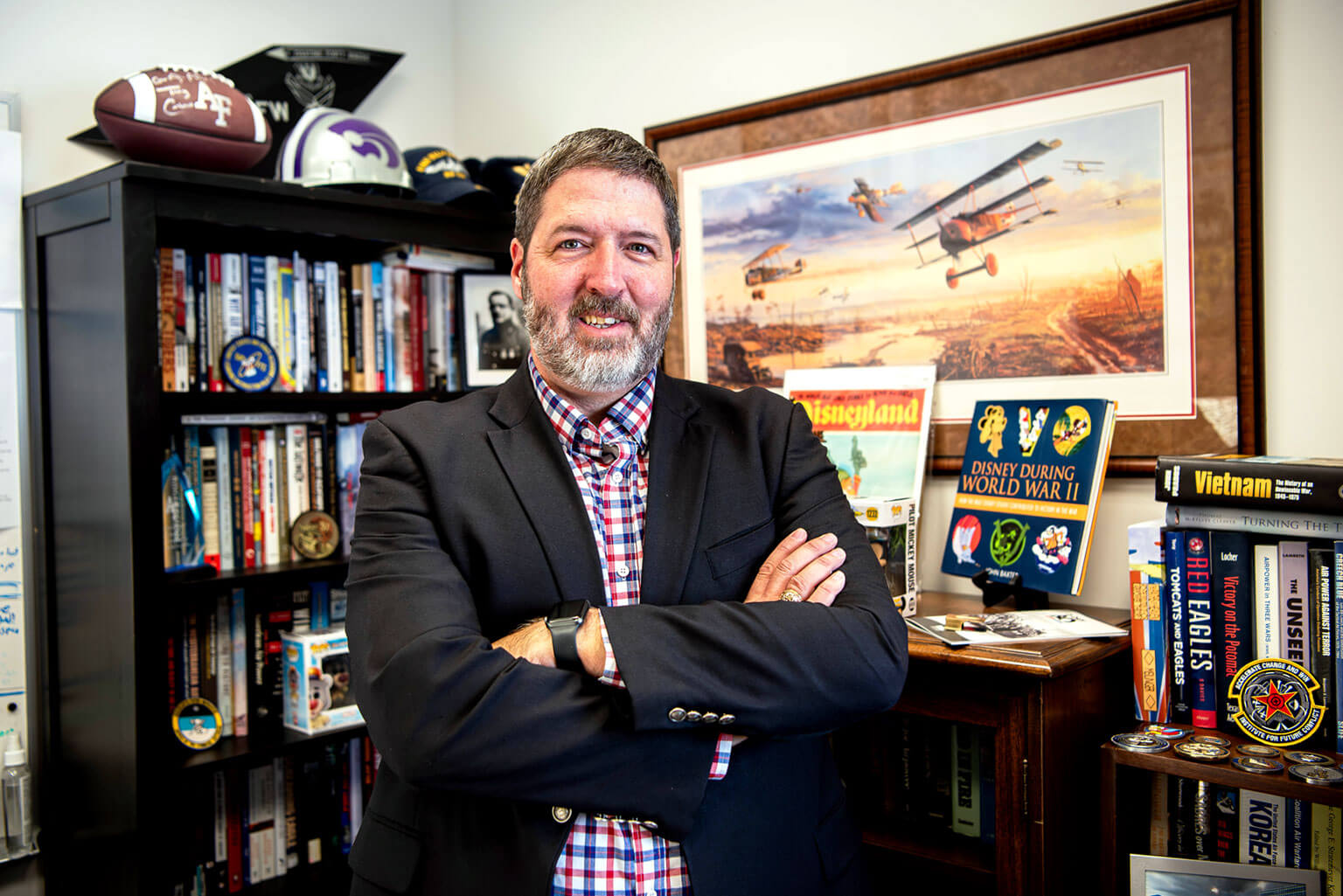Historian reflects on Academy’s 70-year heritage

Dr. Brian Laslie stands in front of the F-4 Phantom static aircraft display on the Terrazzo. Laslie has been the U.S. Air Force Academy’s command historian since 2021. (U.S. Air Force photo by Trevor Cokley)
By Randy Roughton
U.S. Air Force Academy Strategic Communications
U.S. AIR FORCE ACADEMY, Colo. – When Dr. Brian Laslie walks around the U.S. Air Force Academy, he admires the historic aircraft and memorials to U.S. Air Force heroes. His personal favorites are the F-4 Phantom on the Terrazzo and the Women’s Airforce Service Pilots statue on the Honor Court. Each attraction helps tell the story of the Academy’s 70-year history.
“When I think of the almost 70 years of history at the Academy, I think of the generations of cadets who have come through here,” said Laslie, the Academy’s command historian since 2021. “I consider the alumni’s accomplishments and success. I also recognize a strong connection to the aviators and men and women who came before the school’s establishment — the pioneers of World War I through the establishment of a separate Air Force and the creation of the Academy.”
As Laslie reflects on the 70 years since the Academy’s establishment, he identified three eras that helped form it into the institution that serves its cadets today. Those eras are the founding, the Vietnam War and the admission of female cadets.

In 1955, the U.S. Air Force Academy’s first class of 306 men was sworn in. The class trained at Lowry Air Force Base, Colorado, while the permanent location in Colorado Springs was under construction. (U.S. Air Force photo)
The Academy’s founding
On April 4, 1954, President Dwight D. Eisenhower signed legislation that authorized the establishment of the Academy. Airpower advocates such as Billy Mitchell had been preaching the need for the Air Force to have its own Academy for years. Training began in July 1955 at Lowry AFB, Colorado, near Denver while the permanent site was under construction.
Lt. Gen. Hubert Harmon was recalled from retirement to become the Academy’s first superintendent. He approved a curriculum that consisted of military training, physical training, navigation, humanities, science and social sciences. In 1957, “the Father of the U.S. Air Force Academy” died before the first graduation two years later.
“The founding encompasses the establishment of the school, the decision to house it in Colorado Springs, the first class reporting to Lowry and, obviously, the school’s construction,” Laslie said. “This momentous event lay the foundation for our graduates’ contributions in the past seven decades, not only to the Air Force and Space Force but also to our society.”
The Vietnam War era
During the Vietnam War, 150 Academy graduates died, including Capt. Lance Sijan, Class of 1965. Sijan died of his wounds while in captivity Jan. 22, 1968. President Gerald Ford presented the Medal of Honor eight years later to Sijan’s parents. Sijan remains the only Academy graduate to receive the award. In 1976, the Academy’s new dormitory was named for Sijan, and in 2015, a memorial was dedicated to him in the Association of Graduates Plaza of Heroes.
“Vietnam was the first conflict where Academy graduates participated,” Laslie said. “It was as much a watershed event for the Academy as it was for the country. Sixteen Academy graduates received the Air Force Cross, and 205 were awarded the Silver Star. Vietnam established an ideal for what it meant to be an Academy alumnus.”

The U.S. Air Force Academy’s first female cadets train in 1976. Two notable 1980 graduates were Susan Helms, who went on to become an astronaut and reached the rank of lieutenant general, and Janet C. Wolfenbarger, the Air Force’s first female four-star general. (U.S. Air Force photo)
Academy admission opens to women
President Ford signed legislation allowing women to enter military academies Oct. 7, 1975, and the first women entered the Academy the following June. The first co-ed class graduated in 1980. Two notable 1980 graduates were Lt. Gen. Susan Helms and Gen. Janet C. Wolfenbarger. Helms was a mission specialist on four space shuttle missions and a flight engineer on the International Space Station. Wolfenbarger was the first female in the Air Force to attain the rank of four-star general. Today, about 30 percent of each new class is female.
“This change helped redefine in a positive way what it was to be an officer and who could be an officer in the U.S. military,” Laslie said. “We are approaching the 50th anniversary of the first class of female graduates. I have been lucky enough to work with several of them, and they are an outstanding group.”
Academy’s contributions to the community
Through the years, the Academy has been an active partner in the Colorado Springs community. Apart from the U.S. Air Force Academy Honorary Commander Program and regular support of events such as the Holly and Ivy holiday musical performance by the U.S. Air Force Academy Band and Pikes Peak or Bust Rodeo, cadets have volunteered more than 30,000 hours of community service in the past decade. Cadets worked with the Red Cross to install fire alarms in at-risk homes, planted sage plants in Garden of the Gods, and handed out food at the Care and Share Food Bank, among other activities. The Academy’s Cadet Service Leadership program organized the volunteer work, which connects community organizations with cadet volunteers.
“Since I have been at the Academy, I have seen the strong partnership with the community,” Laslie said. “This ranges from seeing cadets at restaurants or downtown on the weekend to the strong support of major events.”

One of Dr. Brian Laslie’s favorite subjects is the 70 years of heritage at the U.S. Air Force Academy. Laslie particularly praises the Academy for its commitment to community service during his 15 years as command historian. (U.S. Air Force photo by Trevor Cokley)
Important years in Academy history
| 1954 | The establishment of the U.S. Air Force Academy |
| 1955 | The arrival of the first cadets |
| 1958 | The cadets move from Lowry AFB, Colorado, to the permanent site |
| 1959 | The graduation of the first class; the first African American cadets enter the Academy |
| 1961 | The U.S. Air Force Academy Preparatory School is activated |
| 1962 | The completion of the Cadet Chapel |
| 1963 | The first African Americans graduate; involvement in the Vietnam War begins |
| 1964 | The Cadet Wing increases from 2,200 to 4,400 cadets |
| 1968 | Sijan Hall, the second dormitory, is completed |
| 1976 | The first class of female cadets arrive |
| 1980 | The graduation of the first female cadets |
| 2020 | 86 cadets commissioned as Guardians in the newly established U.S. Space Force |
| 2023 | The National Character and Leadership Symposium celebrates its 30th anniversary |
| 2024 | 49,000-square-foot Madera Cyber Innovation Center is scheduled to open |
| 2025 | The expected completion date of the new Visitor Center, located outside the North Gate |

Contractors build the U.S. Air Force Academy visitor center outside of the Academy’s North Gate, July 17, 2023. Academy officials expect the steel structure, designed to look like an aircraft taking flight, to serve as an integral part of a 57-acre development named TrueNorth Commons. (U.S. Air Force photo by Trevor Cokley)